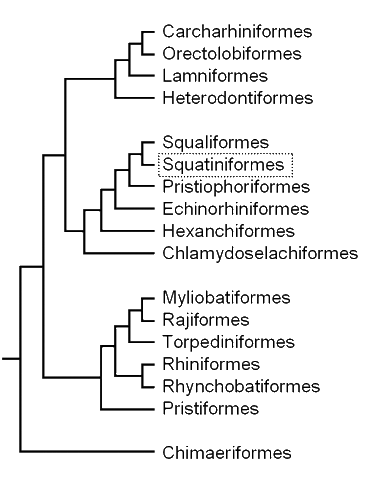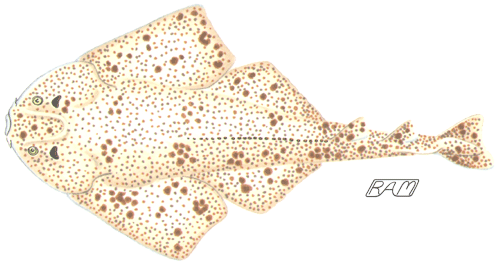Order Squatiniformes:
Angel Sharks — 19 species

- body flattened dorsoventrally (top-to-bottom), with eyes and spiracles located on top of the head
- five pairs of gill slits, located on the ventral surface
- two spineless dorsal fins
- lack of an anal fin
- mouth nearly terminal (at tip of snout); fleshy nasal barbels
- pectoral fins laterally expanded, not attached to the sides of the head
- well-developed caudal fin, on which the lower lobe is slightly longer than the upper
- ovoviviparous
- exclusively marine, ranging from temperate to tropical zones of the eastern and western Atlantic, southwestern Indian, eastern and western Pacific oceans (they do not seem to occur in the central Pacific reaches of Oceania)
- a single genus (Squatina) in the family Squatinidae
The squatiniform sharks superficially resemble the sleepy, bottom-grubbing skates, but have wicked grasping teeth and are fearsome ambush predators. Angel sharks spend much of their time lying motionless on the bottom, typically partially buried in sandy or muddy substrates. A buried angel shark may lie concealed in this way for weeks at a time until a suitably-sized prey animal blunders within striking range; then the buried shark rapidly snaps up its head, expands its pharynx, and protrudes its loosely-slung, trap-like jaws to hoover up the hapless victim. Angel sharks feed on a variety of small bony fishes, crustaceans, cephalopods, bivalves, and gastropods.
Most squatinoids grow to a length of about five feet (1.5 metres), but two of the very largest — the Japanese Angel Shark (Squatina japonica) and possibly the Mediterranean Angel Shark (Squatina squatina) — may grow to more than 6.5 feet (2 metres). The known depth range of angel sharks is from the intertidal down to at least 4,560 feet (1,390 metres). Some angel shark species are apparently migratory. Off the eastern United States, the Atlantic angel shark (Squatina dumeril) seasonally enters shallow waters, moving inshore in the spring and summer and subsequently disappearing (presumably into deeper water offshore).
Some species of angel shark are known to be nocturnal, actively swimming well off the bottom after dusk, apparently foraging under cover of darkness. Tagging studies of the Pacific Angel Shark (Squatina californica) off Catalina Island, California, reveal that this species is most active at night. Sonic telemetry has shown that Pacific angels' swimming activity increases after sundown and peaks after midnight; conventional tagging has revealed this species to be highly variable in its use of living space, some seasonally moving great distances and others remaining in the same general area for many years.
Off southern California, the Pacific Angel Shark apparently gives birth between March and June, dropping 8 to 13 pups in waters between about 180 and 300 feet (55 and 90 metres) deep.
Until recently, there was essentially no market for Pacific Angels. In 1978, Santa Barbara fish processor Michael Wagner changed all that — almost single-handedly. Thanks to Wagner's Herculean promotional efforts, a large, heavily-regulated trawl and gillnet fishery now exists for this species off California; landings jumped from 366 pounds (166 kilograms) in 1977 to over 700,000 pounds (310,000 kilograms) in 1984. Despite this onslaught, divers still occasionally encounter Pacific Angel Sharks on sandy bottoms near kelp beds at depths of 10 feet (3 metres) or greater.
Although angel sharks are not particularly dangerous if left in peace, they can bite aggressively if stepped on or captured — a trait which has earned them the name "sand devil" in some parts of their range.



